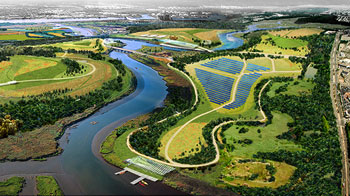Along with participating in the historic Peoples’ Climate March, New York City Mayor de Blasio made a big announcement: committing to reduce emissions 35% by 2025 and 80% by 2050 below 2005 levels – the largest city in the world to commit to this goal.
"There’s a moral imperative to act," he says, calling it a significant step toward a "complete transition away from fossil fuels." And it’s not just words because he released an accompanying 10-year plan that focuses on the city’s biggest source of emissions – its buildings.
NY State set a goal in 2009 to reduce emissions 80% by 2050 below 1990 levels, the exact science-based target the UN is looking for industrialized countries to commit to.
de Blasio also framed it as a way to reduce income inequality in the city, a core issue he was elected on. Energy costs are a much higher proportion of housing expenses for low income people, amounting to a regressive tax, he says. And they often live in less efficient buildings than wealthier residents.
The city will pay for upgrades in private buildings if owners agree to preserve lower income apartments in those buildings.
Incorporated into NYC’s 10-year capital plan will be at least $1 billion for municipal building upgrades such as schools, hospitals, libraries, fire and police stations. Combined with private sector building retrofits, the plan is expected to produce $1.4 billion a year in energy savings while shaving off 10% of emissions (in addition to the 19% cuts under Mayor Bloomberg from 2005 levels). The NYC Council is on board, announcing a package of supportive legislation.
de Blasio is starting where Bloomberg left off, adopting many of his strategies to cut emissions and even expanding on his $20
billion resiliency plan. "The Bloomberg administration put the city on track to achieve a 30% reduction in GHG emissions by 2030 – but it is increasingly clear that this is not enough," he says.
To cut GHG emissions 35% by 2025:
- currently buildings larger than 50,000 square feet must report annually on energy use and that’s being reduced to 25,000 square feet, applying to 16,800 more buildings;
-
Complete efficiency improvements in every city-owned building that has significant energy use and install 100 MW of onsite renewable power.
-
Implement leading edge performance standards for new construction, such as Passive House, or net-zero energy;
-
Develop energy performance targets for existing buildings to be met through voluntary actions and regulations such as performance standards.
Even the powerful Real
Estate Board of New York is on board, with Chair Rob Speyer lauding the efficiency goals as helping to "solidify New York’s standing as a world model of
sustainability."
Still, if private building owners resist, de Blasio says he’ll move to mandates.
Not only will updated appliances, windows and heating systems make NYC apartments use much less energy, they will also make them more comfortable places to live with improved indoor air quality.
The measures will create about 3,500 construction jobs and provide training for more than 7,000 building operators and staff on efficiency.
The plan also calls for 100 megawatts of solar on 300 public buildings, paired with energy storage at emergency shelters, and 250 MW on private buildings, enough to power over 110,000 households.
NYC’s largest solar array is 10 MW on its old landfill:

Read our articles, NYC Fosters Green Buildings With Zone Green and on the latest update to the city’s sustainability plan, PlaNYC.
Read de Blasio’s plan, Built to Last:
